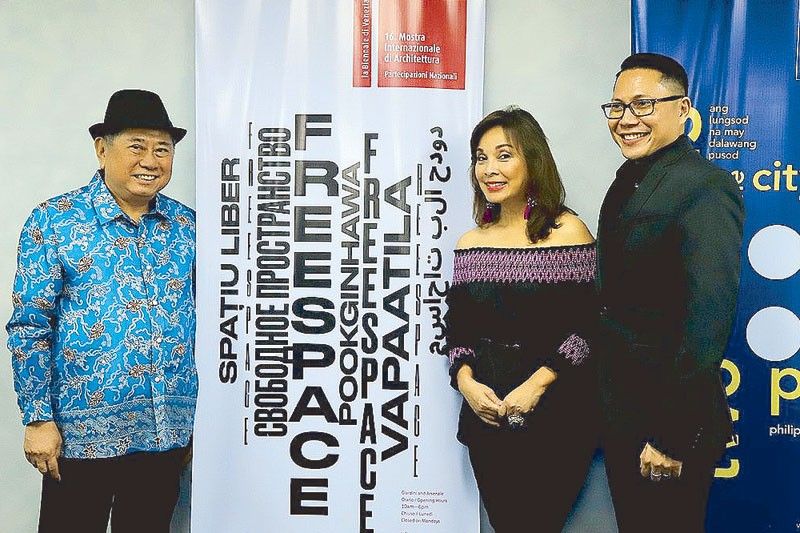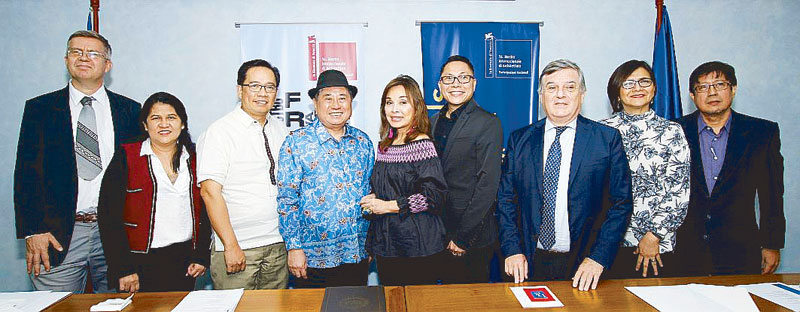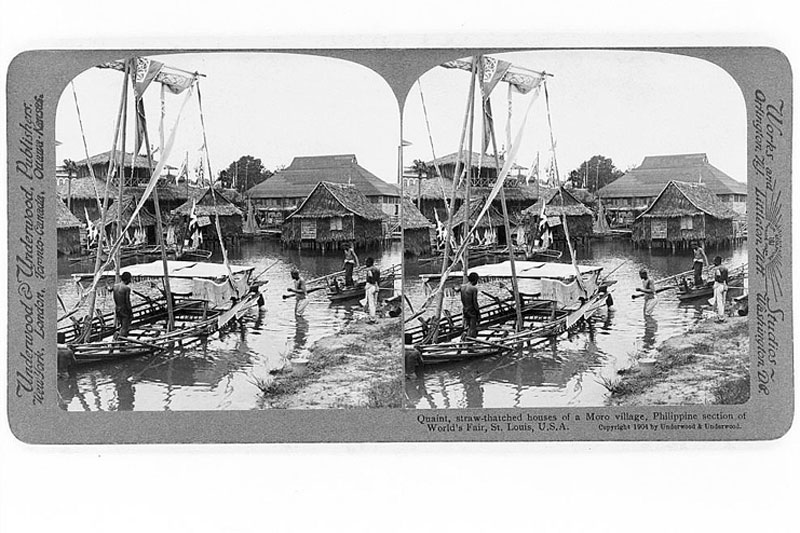‘Our culture is there to converse with the world’


Every art form carries with it a responsibility. Architectural works, for instance, are cultural symbols and works of art. Architecture, therefore, has a significant effect in shaping the hearts and minds of the people because art, in a larger scale, inspires a community and helps build a nation.
The country’s architecture as reminder of the past and purveyor of the future will be highlighted at the Philippine Pavilion at the 16th Venice Architecture Biennale from May 26 to Nov. 25. Our pavilion in the oldest art platform in the world is titled The City Who Had Two Navels, which is inspired by National Artist for Literature Nick Joaquin’s 1961 novel The Woman Who Had Two Navels. The pavilion is curated by Edson Cabalfin, an associate professor at the School of Architecture and Interior Design at the University of Cincinnati.
“I’m triply excited about it,” said Sen. Loren Legarda, the prime mover in the country’s participation at the Biennale, at a press con at the NCCA. This is the fourth time the country is participating at the Venice Biennale. After 51 years of absence, Legarda, so to speak, moved heaven and earth to secure a spot at the 2015 Venice Biennale and tell the world about the intricacy and beauty of our own culture and heritage.
Following its successful comeback to the Venice Art Biennale in 2015, the Philippines mounted its first national pavilion at the Venice Architecture Biennale in 2016. The architecture exhibition is held in even-numbered year while the art biennale is held in odd-numbered year. The Venice Biennale is 58 years old. This year, 63 countries are participating in the architecture exhibition.
On the country’s fourth year in the Venice Biennale, the Office of Sen. Loren Legarda, the National Commission for Culture and the Arts, the Department of Foreign Affairs, with the support of the Department of Tourism, collaborated to bring it to fruition.
 (From left) University of San Carlos’ Bro. Bela Lanyi, UP Mindanao’s architect Jean Marie Juanga, Foreign Affairs Assistant Secretary Leo Lim, Virgilio Almario, Sen. Legarda, Edson Cabalfin, Italian Ambassador Giorgio Guglielmino, De La Salle-College of Saint Benilde’s architect Cynthia Funk and UP Diliman’s architect Armin Sarthou Jr.
(From left) University of San Carlos’ Bro. Bela Lanyi, UP Mindanao’s architect Jean Marie Juanga, Foreign Affairs Assistant Secretary Leo Lim, Virgilio Almario, Sen. Legarda, Edson Cabalfin, Italian Ambassador Giorgio Guglielmino, De La Salle-College of Saint Benilde’s architect Cynthia Funk and UP Diliman’s architect Armin Sarthou Jr.Legarda said she dodged many people’s skepticism about the sustainability of the country’s participation at the Venice Biennale.
“When we started conceptualizing in 2013, it seemed impossible. Backers backed out. We couldn’t form a curatorial team for the Venice Biennale. We did not have funds. Yolanda happened and rehabilitation was, of course, the concern,” recalled Legarda.
Then the impossible became possible in 2015. Then again, kibitzers were acerbically ready: “Hanggang one year lang yan. Hindi na yan masusundan,” Legarda remembered the punches of her critics. But she has proven them wrong.
“Persistence and creativity is the name of the game,” said Legarda, who, early on, was exposed to the beauty of art because her late mother Bessie was an art collector. “Vicente Manansala was the subject of my thesis. H.R. Ocampo visited our home. I dined with and posed for Cesar Legaspi, Ang Kiukok and Federico Alcuaz,” she said.
* * *
“I’m optimistic and hopeful about our participation at the 16th Venice Architecture Biennale. But it is also scary,” Edson Cabalfin, curator of the Philippine Pavilion, told The STAR. But that day, Cabalfin confidently presented the concept of The City Who Had Two Navels to the press.
He said the “first navel” the Philippines will present are images and artifacts depicting the colonial years of the country. “We will present major expositions and world fairs showcasing the Philippines, including the 1887 Exposicion General de las Islas Filipinas in Madrid; the 1904 St. Louis Fair in Missouri; the 1998 Expo Pilipino in Pampanga and other expositions during the colonial and post-colonial Philippines.”
Cabalfin said the “second navel” will dwell on “neoliberal urbanism” or how the present development of the cities in the country affects its progress or, to some extent, stagnation. The purpose of the second navel is to determine whether neoliberalism is the new form of colonialism.
“In the central part of the exhibition, a video installation explores the intersection of the two forces of colonialism and neoliberalism,” said Cabalfin.
Three cities will form the microcosm of the Philippines at the Biennale: Metro Manila, Metro Cebu and Metro Davao. Interpreting these cities are members of a think-tank collaborating with Cabalfin for mounting the exhibit: contemporary artist and filmmaker Yason Banal; TAO (Technical Assistance Organization) Pilipinas Inc., a women-led NGO that assists urban and rural poor groups; De La Salle-College of Saint Benilde; University of San Carlos-School of Architecture, Fine Arts and Design; University of the Philippines Diliman-College of Architecture; and University of the Philippines Mindanao-Department of Architecture.
 Moro Village at the Philippine Reservation, 1904, St. Louis Fair, Stereograph Card, Library of Congress.
Moro Village at the Philippine Reservation, 1904, St. Louis Fair, Stereograph Card, Library of Congress.Architect Cynthia Funk of the College of Saint Benilde gave a preview of how her school conceptualized its part of the navel. “When we were conceptualizing our idea, we were speculating a lot. What if we were never colonized, how would the Philippines look like in 2050? What if the Spaniards won the war and we were never given as payment to the US? What if the Japanese won? What if we were governed by artificial intelligence?”
* * *
By the way, the idea to be examined this year is “Freespace” by biennale curators Yvonne Farrell and Shelley McNamara. The Philippine Pavilion will be housed at the Artiglierie, Arsenale.
“Free space is emphasized in the choreography of our daily life,” said National Artist and NCCA chairman Virgilio Almario. “Our participation in the biennale enriches the narrative of our country. Through this, we negotiate a future in an expanding global world.”
“As an advocate of the preservation of Philippine heritage, I see architecture as a crucial element of building equitable, sustainable and inclusive societies. Through our participation in this year’s Venice Architecture Biennale, we relate our truths as we also learn from the realities of other nations,” said Legarda, who is in her third term as a senator. She expressed hope that her advocacy to promote Philippine art, culture and heritage in the global stage will be continued by others even after her term.
The 16th Venice Architecture Biennale, for Legarda, serves as a reminder of how architecture is not only about building structures but also about inspiring life, shaping society and building a nation.
“Our culture is there to converse with the rest of the world,” Legarda concluded.
(E-mail me at bumbaki@yahoo.com. I’m also on Instagram
@bumtenorio. Have a blessed Sunday!)















